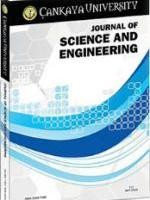Çok Kriterli Permütasyon Akış Tipi Çizelgeleme Problemi için Bir Tavlama Benzetimi Yaklaşımı
Çok Kriterli Permütasyon Akış Tipi Çizelgeleme Problemi için Bir Tavlama Benzetimi Yaklaşımı
___
- [1] J. Dubois-Lacoste, M. L´opez-Ib´a˜nez, and T. St¨utzle, A hybrid TP+PLS algorithm for biobjective flow-shop scheduling problems, Computers & Operations Research, article in press, doi:10.1016/j.cor.2010.10.008
- [2] B. S. H. Khan, G. Prabhaharan, and P. Asokan, A grasp algorithm for m-machine flowshop scheduling problem with bicriteria of makespan and maximum tardiness, International Journal of Computer Mathematics 84 (2007), 1731–1741.
- [3] S. Sayin and S. Karabatı, A bicriteria approach to the two-machine flow shop scheduling problem, European Journal of Operational Research 113 (1999), 435–449.
- [4] B. Tokta¸s, M. Azizo˘glu, and S. K¨oksalan, Two-machine flow shop scheduling with two criteria: Maximum earliness and makespan, European Journal of Operational Research 157 (2004), 286–295.
- [5] C. J. Liao, W.C. Yu, and C.B. Joe, Bicriterion scheduling in the two-machine flowshop, The Journal of the Operational Research Society 48 (1997), 929–935.
- [6] R. L. Daniels and R. J. Chambers, Multi-objective flow-shop scheduling, Naval Research Logistics 37 (1990), 981–995.
- [7] K. Chakravarthy and C. Rajendran, A heuristic for scheduling in a flowshop with the bicriteria of makespan and maximum tardiness minimization, Production Planning and Control 10 (1999), 707–714.
- [8] D. Ravindran, A. Noorul Haq, S. J. Selvakuar, and R. Sivaraman, Flow shop scheduling with multi objective of minimizing makespan and total flow time, International Journal of Advanced Manufacturing Technology 25 (2005), 1007–1012.
- [9] T. Pasupathy, C. Rajendran, and R. K. Suresh, A multi-objective genetic algorithm for scheduling in flow shops to minimize the makespan and total flow time of jobs, International Journal of Advanced Manufacturing Technology 27 (2006), 804–815.
- [10] T. Loukil, J. Teghem, and D. Tuyttens, Solving multi-objective production scheduling problems using metaheuristics, European Journal of Operational Research 161 (2005), 42–61.
- [11] T. Murata, H. Ishibuchi, and H. Tanaka, Multi-objective genetic algorithms and its applications to flowshop scheduling, Computers and Industrial Engineering 30 (1996), 957–968.
- [12] S. G. Ponnambalam, H. Jagannathan, M. Kataria, and A. Gadicherla, A TSP-GA multiobjective algorithm for flowshop scheduling, International Journal of Advanced Manufacturing Technology 23 (2004), 909–915.
- [13] T. K. Varadharajan and C. Rajendran, A multi-objective simulated-annealing algorithm for scheduling in flowshops to minimize the makespan and total flowtime of jobs, European Journal of Operational Research 167 (2005), 772–795.
- [14] B. Yagmahan and M. M. Yenisey, A multi-objective ant colony system algorithm for flow shop scheduling problem, Expert Systems with Applications 37 (2010), 1361–1368.
- [15] J. E. C. Arroyo and V. A. Armentano, Genetic local search for multi-objective flowshop scheduling problems, European Journal of Operational Research 167 (2005), 717–738.
- [16] A. R. Rahimi-Vahed and S. M. Mirghorbani, A multi-objective particle swarm for a flow shop scheduling problem, Journal of Combinatorial Optimization 13 (2007), 79–102.
- [17] A. R. Rahimi-Vahed and A. H. Mirzaei, Solving a bi-criteria permutation flow-shop problem using shuffled frog-leaping algorithm, Soft Computing 12 (2008), 435–452.
- [18] R. Tavakkoli-Moghaddam, A. R. Rahimi-Vahed, and A. H. Mirzaei, A hybrid multi-objective immune algorithm for a flow shop scheduling problem with bi-objectives: Weighted mean completion time and weighted mean tardiness, Information Sciences 177 (2007), 5072–5090.
- [19] A.R. Rahimi-Vahed, B. Javadi, M. Rabbani, and R. Tavakkoli-Moghaddam, A multi-objective scatter search for a bi-criteria no-wait flow shop scheduling problem, Engineering Optimization 40 (2008), 331–346.
- [20] R. Tavakkoli-Moghaddam, A. R. Rahimi-Vahed, and A. H. Mirzaei, Solving a multi-objective no-wait flow shop scheduling problem with an immune algorithm, International Journal of Advanced Manufacturing Technology 36 (2008), 969–981.
- [21] E. Rashidi, M. Jahandar, and M. Zandieh, An improved hybrid multi-objective parallel genetic algorithm for hybrid flow shop scheduling with unrelated parallel machines, International Journal of Advanced Manufacturing Technology 49 (2010), 1129–1139.
- [22] K. Deb, Multi-Objective optimization using Evolutionary Algorithms, John Wiley & Sons, Chichester, 2004.
- [23] J. L. Cohon, Multiobjective Programming and Planning, Dover Publications, Mineola, New York, 2003.
- [24] M. Nawaz, J. E. Enscore, and I. Ham, A heuristic algorithm for the m-machine, n-job flowshop sequencing problem, OMEGA 11 (1983), 91–95.
- [25] C. Rajendran, Heuristic algorithm for scheduling in a flowshop to minimize total flowtime, International Journal of Production Economics 29 (1993), 65–73.
- Yayın Aralığı: Yılda 2 Sayı
- Başlangıç: 2009
- Yayıncı: Çankaya Üniversitesi
Complex Solutions for the Fisher Equation and the Benjamin-Bona-Mahony Equation
Cemalettin Öcal Fidanboy, Mehmet Reşit Tolun
Emre CEYHAN, Ayşe MERCANGÖZ, Nimet KARAKOÇ, Sevim BİLGİÇ
Bayesgil VAR Modelinin Gerçek Zaman Dizileri için Kestirim Amaçlı Kullanılması
Parmak Hareketlerinin Bilgisayarlı Yorumlanmasıyla Tek Oktavlı Notaların Seslendirilmesi
Yutucu Yarım Düzlemin Kenarından Kırınan Üniform Alanların Fiziksel Optik Yöntemiyle Hesabı
Türkiye Faunası için Üç Yeni Oribatid Akar Türü (Acari, Oribatida)
Ayşe Toluk, Sedat Per, Şule Baran, Hatice Aydın Yüksel, Pınar Coşkuner, Nusret Ayyıldız
Some Applications to Lebesgue Points in Variable Exponent Lebesgue Spaces
Çok Kriterli Permütasyon Akış Tipi Çizelgeleme Problemi için Bir Tavlama Benzetimi Yaklaşımı
Yatırım Projelerinin Net Bugünkü Riske Maruz Değer Göstergesi Kullanılarak Karşılaştırılması
